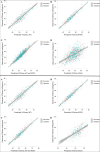VO2max prediction based on submaximal cardiorespiratory relationships and body composition in male runners and cyclists: a population study
- PMID: 37162318
- PMCID: PMC10198721
- DOI: 10.7554/eLife.86291
VO2max prediction based on submaximal cardiorespiratory relationships and body composition in male runners and cyclists: a population study
Abstract
Background: Oxygen uptake (VO2) is one of the most important measures of fitness and critical vital sign. Cardiopulmonary exercise testing (CPET) is a valuable method of assessing fitness in sport and clinical settings. There is a lack of large studies on athletic populations to predict VO2max using somatic or submaximal CPET variables. Thus, this study aimed to: (1) derive prediction models for maximal VO2 (VO2max) based on submaximal exercise variables at anaerobic threshold (AT) or respiratory compensation point (RCP) or only somatic and (2) internally validate provided equations.
Methods: Four thousand four hundred twenty-four male endurance athletes (EA) underwent maximal symptom-limited CPET on a treadmill (n=3330) or cycle ergometer (n=1094). The cohort was randomly divided between: variables selection (nrunners = 1998; ncyclist = 656), model building (nrunners = 666; ncyclist = 219), and validation (nrunners = 666; ncyclist = 219). Random forest was used to select the most significant variables. Models were derived and internally validated with multiple linear regression.
Results: Runners were 36.24±8.45 years; BMI = 23.94 ± 2.43 kg·m-2; VO2max=53.81±6.67 mL·min-1·kg-1. Cyclists were 37.33±9.13 years; BMI = 24.34 ± 2.63 kg·m-2; VO2max=51.74±7.99 mL·min-1·kg-1. VO2 at AT and RCP were the most contributing variables to exercise equations. Body mass and body fat had the highest impact on the somatic equation. Model performance for VO2max based on variables at AT was R2=0.81, at RCP was R2=0.91, at AT and RCP was R2=0.91 and for somatic-only was R2=0.43.
Conclusions: Derived prediction models were highly accurate and fairly replicable. Formulae allow for precise estimation of VO2max based on submaximal exercise performance or somatic variables. Presented models are applicable for sport and clinical settling. They are a valuable supplementary method for fitness practitioners to adjust individualised training recommendations.
Funding: No external funding was received for this work.
Keywords: VO2max; athletes; body composition; cardiopulmonary; human; medicine; prediction; threshold.
© 2023, Wiecha et al.
Conflict of interest statement
SW received payment for leading CPET workshops at IX Małopolskich Warsztatach Niewydolności Serca. The author has no other competing interest to declare, PK, PS, IC, MP, AK No competing interests declared, TK has received funding from the Institute of Sport - National Research Institute. The author has received consulting fees for regular coaching and consulting work with private clients, Polish Triathlon Federation and The Triathlon Squad professional triathlon team. The author has no other competing interests to declare
Figures



Update of
- doi: 10.1101/2023.02.03.527004
Similar articles
-
Transferability of Cardiopulmonary Parameters between Treadmill and Cycle Ergometer Testing in Male Triathletes-Prediction Formulae.Int J Environ Res Public Health. 2022 Feb 6;19(3):1830. doi: 10.3390/ijerph19031830. Int J Environ Res Public Health. 2022. PMID: 35162854 Free PMC article.
-
COVID-19 and athletes: Endurance sport and activity resilience study-CAESAR study.Front Physiol. 2022 Dec 16;13:1078763. doi: 10.3389/fphys.2022.1078763. eCollection 2022. Front Physiol. 2022. PMID: 36589442 Free PMC article.
-
Normative cardiopulmonary exercise data for endurance athletes: the Cardiopulmonary Health and Endurance Exercise Registry (CHEER).Eur J Prev Cardiol. 2022 Mar 25;29(3):536-544. doi: 10.1093/eurjpc/zwab150. Eur J Prev Cardiol. 2022. PMID: 34487164
-
Is a verification phase useful for confirming maximal oxygen uptake in apparently healthy adults? A systematic review and meta-analysis.PLoS One. 2021 Feb 17;16(2):e0247057. doi: 10.1371/journal.pone.0247057. eCollection 2021. PLoS One. 2021. PMID: 33596256 Free PMC article.
-
Validity of Submaximal Step Tests to Estimate Maximal Oxygen Uptake in Healthy Adults.Sports Med. 2016 May;46(5):737-50. doi: 10.1007/s40279-015-0445-1. Sports Med. 2016. PMID: 26670455 Review.
Cited by
-
Influence of voluntary isocapnic hyperpnoea on recovery after high-intensity exercise in elite short-track speedskaters - randomized controlled trial.BMC Sports Sci Med Rehabil. 2024 Jun 20;16(1):137. doi: 10.1186/s13102-024-00927-0. BMC Sports Sci Med Rehabil. 2024. PMID: 38902811 Free PMC article.
-
Submaximal Oxygen Deficit During Incremental Treadmill Exercise in Elite Youth Female Handball Players.Sports (Basel). 2025 Jul 31;13(8):252. doi: 10.3390/sports13080252. Sports (Basel). 2025. PMID: 40863761 Free PMC article.
-
Optimizing the Interpretation of Cardiopulmonary Exercise Testing in Endurance Athletes: Precision Approach for Health and Performance.Transl Sports Med. 2025 Aug 20;2025:5904935. doi: 10.1155/tsm2/5904935. eCollection 2025. Transl Sports Med. 2025. PMID: 40881385 Free PMC article. Review.
-
Prediction of peak oxygen consumption using cardiorespiratory parameters from warmup and submaximal stage of treadmill cardiopulmonary exercise test.PLoS One. 2024 Jan 10;19(1):e0291706. doi: 10.1371/journal.pone.0291706. eCollection 2024. PLoS One. 2024. PMID: 38198496 Free PMC article.
-
Reticulocyte Count and Exercise Performance in Elite Athletes: A Retrospective Study.Sports (Basel). 2025 May 30;13(6):169. doi: 10.3390/sports13060169. Sports (Basel). 2025. PMID: 40559681 Free PMC article.
References
-
- Altman DG, Bland JM. Measurement in medicine: The analysis of method comparison studies. The Statistician. 1983;32:307. doi: 10.2307/2987937. - DOI
-
- Ashfaq A, Cronin N, Müller P. Recent advances in machine learning for maximal oxygen uptake (Vo2 Max) prediction: A review. Informatics in Medicine Unlocked. 2022;28:100863. doi: 10.1016/j.imu.2022.100863. - DOI
Publication types
MeSH terms
LinkOut - more resources
Full Text Sources
Miscellaneous

